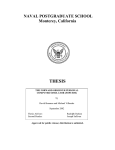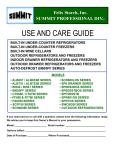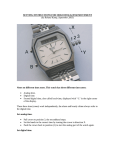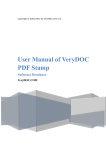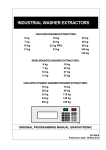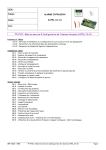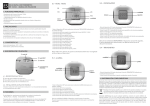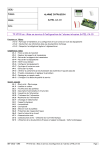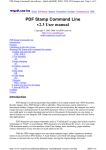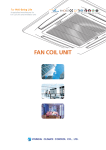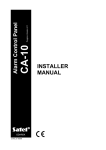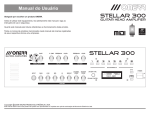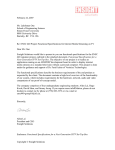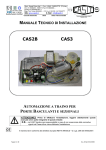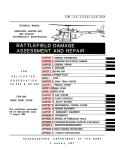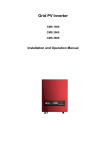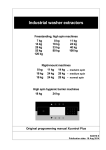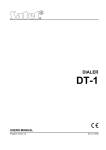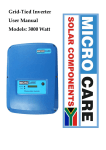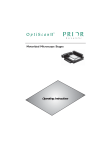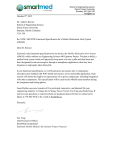Download - 1 - October 23, 2009 Dr. John S. Bird School of
Transcript
October 23, 2009 Dr. John S. Bird School of Engineering Science, Simon Fraser University, Burnaby, BC, V5A 1S6 Re: ENSC 440 Functional Specifications for Auto-Splice Conductivity Analyzer Dear Dr. Bird: The enclosed document from Prospect1 Inc. outlines functional specification for the Auto-Splice Conductivity Analyzer (ASCA). The aim of this project is to design a device that uses Hall Effect Sensors to calculate magnetic field intensity in splices in overhead transmission lines. It can then be used to analyze the imbalance of current in strands of an ACSR (Aluminum Conductor Steel Reinforced) overhead wire. Attached LEDs and LCD display on the device will help the user identify the extent of damage present in the splice. The functional specifications mentioned in this document provide a set of high-level standards and requirements for the ASCA device’s functionality for both the proof-ofconcept and product phases. The management team along with test and design engineers will make use of this document in research and development activities. Prospect1 Inc. consists of four enthusiastic and hard working fourth year Engineering Science students: Amir Najafzadeh, Sam Hoque, Milad Moezzie and Zhouhao Cui. We are very excited about the opportunity this project may hold in lessening the failure rates of automatic splices in overhead distribution systems. Please feel welcome to contact us if you have any questions or concerns by phone at (778) 229-9190 or by e-mail at [email protected] Sincerely yours, Amir NajafZadeh CEO Prospect1 Inc. Enclosure: Functional Specifications for Auto-Splice Conductivity Analyzer Copyright ©, 2009 Prospect1 Inc. -1- Functional Specifications for Auto-Splice Conductivity Analyzer Project Team: Amir Najafzadeh Sam Hoque Mlad Moezzie Zhouhao Cui Contact Person: Amir Najafzadeh [email protected] Submitted to: Dr. John Bird Steve Whitmore Jason Lee School of Engineering Science Simon Fraser University Issued date: October 23, 2009 Revision: 1.3 Copyright ©, 2009 Prospect1 Inc. -2- Executive Summary Overhead transmission cables are a standard mean of distributing electricity to homes. The wires in a transmission line are connected with one another via metal clamps referred to as automatic splices or auto-splices. There is a growing concern over the failure rate of these auto-splices due to corrosion. This limits conductivity and also lessens the current passage area throughout the wire. An overhead wire in such a condition may eventually break and the live wire may fall on the ground. In addition to loss of power and electricity transmission, this introduces risk of electrocution and fire [1]! A live cable on the ground is a serious safety concern. Currently there is no specific solution for this splice issue. Prospect1 Inc. has come up with an idea and a technology to overcome this safety issue. As splices age, Aluminum components oxidize to form an insulating barrier thereby increasing their resistance and causing a current imbalance in cables’ strands [2]. We concentrated our effort on the study of this current imbalance and the resulting magnetic field around the cables’ strands and came up with ASCA – a device that uses Hall Effect Sensors to measure this change in magnetic field intensity to monitor failure in splices. Development of the ASCA device is divided in to two phases. Upon completion of the first phase, the device will be able to obtain data regarding magnetic field intensity around live wire utilizing the Hall Effect Sensors and store them at the MCU. In the second phase, this data will then be displayed on the LCD along with an LED indicator. During this phase, the casing of the device will also be prepared and the product will reach completion. This document presents the functional specifications of the ASCA device. The main focus here is to outline the functional specifications of the proof of concept prototype for ASCA. This document also mentions some future functionality that can possibility be added to the final commercial product as an upgrade later. . Copyright ©, 2009 Prospect1 Inc. -3- Table of Contents Executive Summary........................................................................................ 3 List of Figures ................................................................................................. 5 Glossary .......................................................................................................... 5 1. Introduction................................................................................................. 6 1.1 Scope ..................................................................................................... 6 1.2 Intended Audience................................................................................. 6 1.3 Classification ......................................................................................... 6 2 System Requirements .................................................................................. 7 2.1 System Overview .................................................................................. 7 2.2 General Requirements ........................................................................... 8 2.3 Physical Requirements .......................................................................... 8 2.4 Electrical Requirements ........................................................................ 9 2.5 Mechanical Requirements ................................................................... 10 2.6 Environmental Requirements.............................................................. 10 2.7 Standards ............................................................................................. 10 2.8 Reliability and Durability.................................................................... 11 2.9 Safety Requirements............................................................................ 11 2.10 Performance Requirements ............................................................... 11 2.11 Usability Requirements ..................................................................... 12 3 User Documentation .................................................................................. 12 4 System Test Plan........................................................................................ 13 5 Conclusion ................................................................................................. 14 6 References.................................................................................................. 15 Copyright ©, 2009 Prospect1 Inc. -4- List of Figures Figure 1: High-Level Functional Block Diagram...........................................7 Figure 2: High-Level Block Diagram for System Test Plan.........................13 Glossary ASCA Auto-Splice Conductivity Analyzer LCD Liquid Crystal Display LED Light Emitting Diode MCU Arduino Duemilanove Micro Controller User Certified Technicians/Electricians who are authorized to perform maintenance and testing on overhead transmission lines Hot Stick An insulated rod usually made of fiber glass. It can be of extendable length [3] ANSI American National Standards Institute CGSB Canadian General Standards Board CSA Canadian Standards Association NERC North American Electric Reliability Corporation IEC International Electrotechnical Commission RoHS Restriction of the Use of Certain Hazardous Substances in Electrical and Electronic Equipment Regulations MTBF Mean time between failures Copyright ©, 2009 Prospect1 Inc. -5- 1. Introduction Auto-Splice Conductivity Analyzer (ASCA) is designed to determine current imbalance in overhead transmission line cables. From the resulting magnetic field around the cables’ strands, this imbalance can be found, and used to verify if the splice is faulty. The device has an LCD on it, which shows the intensity of the magnetic field around the splice. There are also a couple of LEDs on the device, which lets the user know if the intensity of the magnetic field is within range or out of range. ASCA can be attached to the wire as a slide-on device to obtain data. The requirements for the ASCA device, as proposed by Prospect1 Inc. are described in this functional specification. 1.1 Scope This document lists all the functional requirements that must be met by a functional ASCA. These listed requirements will guide various design phases later. It also serves as a basis for Design Specification later. 1.2 Intended Audience The document is intended for the use of all Prospect1 Inc. members. It will also serve as a tool to the project manager who shall use it to evaluate progress throughout the different development phases. It will also serve as a guide to him to comply with necessary manufacturing and usability standards. Design engineers shall follow this document to meet overall design requirements from production to implementation of device. Test engineers shall use this document to assess the match in functionality between the actual device and the guidelines outlined here. Marketing department may also use this document to develop marketing materials and identify similarities in features (if any) with competitor’s products. 1.3 Classification Throughout this document, the following convention shall be used to denote functional requirements: [FSn-p] <“A functional requirement”> This format of representation is compatible with the CSA requirements of referencing. Here, n is the functional requirement reference number and p is the priority of the functional requirement denoted by one of the three values: I, II or III. [5] Copyright ©, 2009 Prospect1 Inc. -6- These three values correspond to the following implementation stages: I. The requirement applies only to the stage of proof-of-concept. II. The requirement applies to both the proof-of-concept and the final prototype stages. III. The requirement applies only to the final production system. 2 System Requirements General requirements applicable to the ASCA as a complete system are identified in this section. 2.1 System Overview The ASCA system can be modeled at a high-level as shown in Figure 1. Data Output User Input Data Input On/Off Switch Hall Effect Sensors detect voltage level in Splices Memory Data is displayed on LCD Data is stored in MCU LED indicates condition of data Figure 1: High-Level Functional Block Diagram Due to time and budget constraints, in the proof-of-concept stage of development, only selected functionality aspects of the ASCA system will be designed and implemented. This stage will implement the fundamental aspects of data capturing, data storing and extraction of data via LCD and LED. Fine tuning the device for higher range of power transmission will be left as a future upgrade and more potential sales. Copyright ©, 2009 Prospect1 Inc. -7- The device is turned on by pushing the ‘On/Off’ switch by the user. Once turned on, it will be attached to a hot stick and elevated to a height in line with the splice on a transmission wire. Then the device will be put on the splice through the opening and slid along its length. At this time, raw data will be captured by the two Hall Effect sensors [4] and recorded in the memory. Attempt is made to have the sensors located close enough to the wire within mechanical constraints. This will assure significant reduction in noise signal as well as accurate data accumulation. The data is then stored, in small blocks, in a buffer in the Processor Memory. The user then uses the hot stick to bring the ASCA device down. Once it is back in hand, the user presses the ‘View Data’ button to observe captured data. This is when stored data is displayed on the LCD along with an LED indicator. There are three LEDs on the device and they represent the following: - Green LED: Data is within optimal range - Red LED: Data is out of range - Blue LED: Data is irrelevant or there is insufficient data 2.2 General Requirements [FS1-II] The ASCA device shall have an idle state in which no data is captured or displayed on the LCD. This idle state is when the device is turned off [FS2-II] The system shall activate when the ‘On/Off’ switch is turned ‘On’ [FS3-II] Sensors and connection wires shall be minimally intrusive to the user [FS4-III] The internal construction of the device shall be modular, allowing for substitution/addition of features in future models [FS5-III] The device must be mountable onto a hot stick [FS6-II] The device shall be battery powered [FS7-III] The suggested retail price of the device shall be under CDN$300 2.3 Physical Requirements [FS8-III] The device shall be fabricated with a hard cover box to protect the components and electronics from possible damage [FS9-III] The hard cover protection shall be made of durable plastic material which has some degree of heat resistance Copyright ©, 2009 Prospect1 Inc. -8- [FS10-II] Due to Hall Effect Sensor’s sensitivity range, the distance between the 2 walls (the inner diameter) where the sensors are mounted must not be greater than 3cm [FS11-II] The system shall have an LCD display and three LEDs [FS12-III] The switches and buttons shall be placed reasonably and intuitively, so that it is difficult to press buttons unintentionally [FS13-III] The device must have a hook attached to it, so that it can be mounted by a hot stick [FS14-III] The device shall not have any sharp edges in order to protect the user [FS15-III] Weight of device shall not exceed 1.0 kg [FS16-III] The system shall be protected from small static shocks and bumps 2.4 Electrical Requirements [FS17-II] The power supply shall be sufficient to support necessary power needed to operate the sensors and the MCU [FS18-II] Power consumption shall be as low as possible [FS19-II] The power supply shall be sufficient to support simultaneous operation of the entire internal circuitry [FS20-II] Batteries along with the power consumption of the circuit shall be designed so that the device can operate for at least 14 hours continuously [FS21-III] Batteries in the system shall be easily replaceable [FS22-I] Key voltage nodes shall be easily accessible for measurement, troubleshooting and debugging [FS23-III] Device may be used in conjunction with other electrical equipments without interference [FS24-III] The device will have no exposed wiring Copyright ©, 2009 Prospect1 Inc. -9- 2.5 Mechanical Requirements [FS25-III] The mechanical components of the ASCA device shall not be visually or physically obtrusive [FS26-III] The device casing shall be durable and robust to withstand repetitive rigorous outdoor use [FS27-III] User interface shall include clearly marked pushbuttons 2.6 Environmental Requirements [FS28-III] The analyzer shall operate normally within an elevation range from sea level to 2000 meter above sea level [FS29-III] The device shall operate between temperatures of - 40 degrees Celsius to 80 degrees Celsius [FS30-III] The device shall operate between 0% to 60% relative humidity [FS31-III] Operational environment is an outdoor overhead transmission wire line [FS32-II] The system will produce virtually no noise while active or inactive [FS33-II] Noise produced during operation will be minimized and below 50dB [FS34-I] All components will be connected to the main device with silver solder as opposed to traditional tin/lead type of solder [FS35-II] Vibration will not adversely effect the operation of the device 2.7 Standards [FS36-III] The device shall conform to CGSB-44.232-2002 standards [9] [FS37-III] The device shall conform to ANSI standards [FS38-III] The device shall meet CSA requirement CSA-ISO 9241-5-00 [10] [FS39-III] The device shall conform to IEC 62369-1 standards [FS40-III] The device shall meet NERC standards [FS41-III] All components of the device shall be RoHS compliant Copyright ©, 2009 Prospect1 Inc. - 10 - 2.8 Reliability and Durability [FS42-III] The device shall be durable enough to withstand day-to-day physical treatment and harsh environment [FS43-III] The device shall be serviceable by trained technicians [FS44-III] Regular service intervals shall be at least yearly [FS45-III] The user interface shall be resistant to breakage under normal operating conditions [FS46-III] The MTBF of the chair shall be no less than 20,000 hours [FS47-III] System performance shall not degrade from normal use [FS48-III] The system will have a lifespan of at least 3 years of normal use 2.9 Safety Requirements [FS49-III] The device shall be covered with a smooth insulating layer, thus it would not cause bodily harm to user [FS50-III] The electronic and mechanical components along with the power connections shall remain in an enclosure [FS51-II] It shall not cause fire hazard in case of malfunction [FS52-II] The device shall not spontaneously combust [FS53-III] The display and user interface shall not be a strain to the eyes of users [FS54-II] Signal emissions from the device shall not interfere with other electronics [FS55-II] The system should not provide any static shock when touched 2.10 Performance Requirements [FS56-III] The manual On/Off button on the device shall respond to the user instantaneous [FS57-III] The device shall retrieve data from the splice 10 times every second [FS58-III] The device shall return the result of the condition of the splice within 1ms Copyright ©, 2009 Prospect1 Inc. - 11 - [FS59-II] The total time taken for data retrieval and data analysis and display of the result is less than 2 seconds [FS60-II] Data Storage unit shall be accessible by the microcontroller or other memory reading devices at all times [FS61-III] Size of Data Storage unit shall be sufficient for at least 14 hours of normal operation 2.11 Usability Requirements [FS62-II] The device shall reset itself after it is turned on [FS63-III] The device shall have an interface for external connection with a PC for diagnostic purposes [FS64-III] Device shall be pre-configured with necessary adjustments and technical setups before delivering it to the end user [FS65-III] The device shall have clear and proper labeling [FS66-III] The system shall be intuitive to use [FS67-III] The device firmware shall be upgradeable by a service person 3 User Documentation [FS68-III] User documentation shall include a website with general and technical support information [FS69-III] A user manual may be written in different languages including English. The user manual shall be written for users with minimal knowledge [FS70-III] A detailed installation guide for technicians and vendors shall be created [FS71-III] Both the user manual and the installation guide will be available on the company website [FS72-III] A detailed list of parts used for the device shall be created Copyright ©, 2009 Prospect1 Inc. - 12 - [FS73-III] There will be a ‘Frequently Asked Questions’ section both in the user manual and on the company website [FS74-III] To ensure quality assurance, a detailed copy of the warranty shall be provided along with the device [FS75-III] Prosect1 Inc. shall also provide copies of all documents on the company website for easy access 4 System Test Plan In order for the system to function in a reliable manner, it is necessary to test it during different stages of design and implementation, prototype building and manufacturing. To avoid errors, the general test plan is to test each module as it is built, and to retest the modules upon integration into the complete unit. From designing this device to building a prototype, the tests associated with various stages can be divided in to three main categories. For this project, they will be named as unit testing, constituent testing and prototype testing. Unit Testing Test Individual Module Test Individual Module Constituent Testing Test Integrated Module of System Test Integrated Module of System Test Individual Module Test Individual Module Prototype Testing Test Integrated Module of System Complete System Test by Designer Complete System Test by Potential User Figure 2: High-Level Block Diagram for System Test Plan Copyright ©, 2009 Prospect1 Inc. - 13 - Unit testing refers to the test of each and every unit and element in the design. This is done on both the hardware and software segments. These tests ensure that the design and internal components are functioning in a desired manner. Also, at this stage of testing, boundary conditions are taken into consideration. This can assure a hassle free integration later on. Constituent testing is the second step in system testing. At this stage the design gets divided into smaller building blocks. For example, one such small block may be the display of output data through the combination of LCD and LED. Depending on the data stored at the MCU, the output signal will show a specific display on the LCD and accordingly an LED light will flash. Other such blocks that may need testing can include; - obtaining differential data through the Hall Effect sensors, - storing data at MCU - extracting data from MCU, etc. At this stage, a general overview of unit testing of each component may be reviewed again. This can help eliminate potential errors that may arise at this stage of testing. The last step in the system test plan is prototype testing. After the smaller blocks pass constituent testing, they are ready for integration. Once integrated, prototype testing can make sure that the smaller blocks put together are functioning well and are in cohesion. At this stage, boundary conditions shall be tested in greater details again. This may give the designers an idea on how well the functionality of the device in different conditions matches its functional specifications. It may also be a good idea to have potential users try the prototype before commercialization or mass production of this device is done. Their feedback may point to any negativity in the device or lead to possible upgrades and improvements for future. If at any point of the building process a change in either design or raw material was found necessary, the system shall be tested again from the stage where changes were needed. 5 Conclusion The functional specifications clearly outline the capabilities, features and requirements of the Auto-Splice Conductivity Analyzer (ASCA) device. Development of a final prototype device shall take place in two distinct phases, both of which are proceeding in parallel. Work has already begun and it is expected that the above mentioned functional requirements that applies to the proof-of-concept model (marked with I or II) will be completed by the target date of December 2009. Copyright ©, 2009 Prospect1 Inc. - 14 - 6 References [1] Transmission & Distribution World, “Forensic Analysis of Automatic Splices Leads to Change”, http://tdworld.com/mag/power_forensic_analysis_automatic [2] Ensuring the Health of Our Power Lines, “Power line and connector splice sensor”, http://www.swri.org/3PUBS/ttoday/Summer06/PoweLines.htm [3] TEL-O-POLE II Parts List, Hastings, http://www.westernsafety.com/Hastings/hastingspg1.html [4] Busse, G., Hemelrijck, D., Solodov, I., Anastasopoulos, A., Emerging Technologies in NDT, “How Infrared has been used in the past”, pg 304-310 [5] Engineering Science 305/440, http://www.ensc.sfu.ca/~whitmore/courses/ensc305 Copyright ©, 2009 Prospect1 Inc. - 15 -















